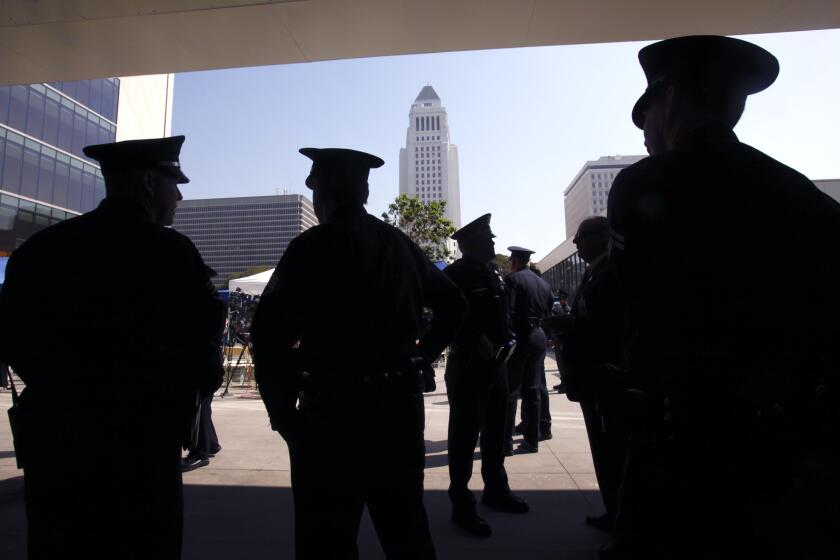Journalists and Public Need a Strong Shield
- Share via
Deanne Stillman didn’t expect to wind up in a thorny legal fight over reporters’ rights when she began her investigation of a vicious double murder in the desert community of Twentynine Palms.
Stillman, a contributing writer to Los Angeles magazine, spends a lot of time in the desert, hiking in Joshua Tree National Park and hanging out in Twentynine Palms, a community dominated by a large Marine base.
Reading the local paper one day, she spotted a story about the murders of 15-year-old Mandi Scott and Rosalie Ortega, 20, her friend. Each had been stabbed 33 times with an 11-inch kitchen knife. Marine Valentine Underwood, 34, a Gulf War veteran, was charged with the deaths, and faces trial for murder.
“It resonated with me on every level,” Stillman said.
Stillman was drawn to the desert. So were Mandi, her family and her friends. Mandi had a problem-filled youth. So had Stillman. “I grew up as a misfit and I identified with her problems,” said Stillman. “I knew this was a story I was going to tell. I felt it called me.”
Stillman traced Mandi’s life up to her death by tracking down family and friends. It took her 3 1/2 years to get the story, which appears in the April issue of Los Angeles.
But her own story didn’t end when the magazine came out. The lawyer for the accused Marine demanded Stillman’s notes, tape recordings and other materials.
This plunged her into a long-running dispute between defense attorneys and journalists over the right of reporters to protect their sources. Once important only to the press and the bar, the dispute is now known to the public because it often figures in high publicity trials such as the O.J. Simpson case, where a TV reporter successfully fought to keep her source’s identity confidential.
*
At first, before there was a legal dispute, there was just a tantalizing story. Stillman began her search. Her sources, Mandi’s circle of friends, were alienated from society and its institutions. To get them to talk, Stillman had to show empathy with them.
“I had to hang out in desert bars that open at dawn,” she said. We were chatting in the patio of the Rose Cafe, a center of Venice chic, where the decaf espresso is a contrast to the beer and shots of a desert saloon. It wasn’t difficult, she said. “First of all, I’m a girl. People were buying me rounds. And I like rock and roll.
“One person would lead to another,” she said. “They were constantly changing phone numbers because they don’t pay their bills. Some of them don’t have phones. I would hang out in the video arcade until I ran into them. Some of Mandi’s friends called me from jail.”
*
This is the way reporters work. The skill is sometimes employed in the pursuit of sleaze. But mostly, the tedious process is done to expose corruption and injustice and, as in Stillman’s story, to report on the human condition.
That is why the California voters in 1980 approved a constitutional amendment, the shield law, protecting reporters’ rights to keep confidential “unpublished information” gathered in pursuit of a story.
No whistle-blower would talk to a reporter without this protection. No family would talk about neighborhood drug dealers or dangerous conditions in the schools if they knew all their words would end up in the hands of lawyers.
Defense attorneys Garrett J. Zelen and Shannon McDonald said the material is needed for their client’s defense, perhaps to attack the credibility of the witnesses. Sources, Zelen said, “were freely willing to talk to her, [but] they mostly refused to talk to me or my investigator.”
Mark Helm, representing Stillman and Los Angeles magazine, disagreed. He noted that the shield law is anchored on the belief that “forcing reporters to reveal sources they had promised to protect will over the long run simply deprive the public of important information.”
That’s the way I see it. But I know this is not 1980 when the shield law was passed. Journalists were still viewed as heroic characters seven years after Watergate. I wouldn’t bet on a shield law passing today.
Stillman must defend herself in an increasingly press-hostile time, in a San Bernardino County hearing that probably won’t get much big city coverage. It’s an important case. The outcome means as much to the press, and the public it informs, as anything that happened in the O.J. trial.
More to Read
Sign up for Essential California
The most important California stories and recommendations in your inbox every morning.
You may occasionally receive promotional content from the Los Angeles Times.










